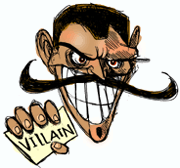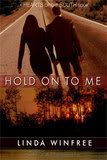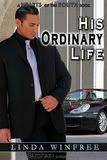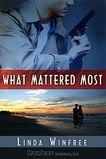The Villain Tri-Fecta: Part Two -- Your Villain In Conflict
The difference between character and characterization centers around conflict.
Characterization is the cumulative affect of things you assign your character: eye and hair color, height and weight, attitude, disposition. Character is what he's really made of; what oozes out of his pores once he's squeezed by conflict.
 A character without conflict isn't a character at all, just a place holder. While that might suffice for those quickie stand ins--the waitress, the gas station attendant, the next door neighbor--it won't work for anyone in your plot that matters. Namely your hero, your heroine and your villain.
A character without conflict isn't a character at all, just a place holder. While that might suffice for those quickie stand ins--the waitress, the gas station attendant, the next door neighbor--it won't work for anyone in your plot that matters. Namely your hero, your heroine and your villain.
Villain's, IMHUO, are as important as your hero/heroine. Arguably, even moreso. (I'm talking Romantic Suspense here, since that's what I write.) I, personally, don't like that idea, because, as I mentioned in my last post, I don't particularly like creating villains. Or, I should say deep villains. For me, staying on the surface is much more comfortable.
But comfortable isn't enough for memorable, compelling villains.
So toss as much conflict at your villain as you do your hero and heroine. And make it complex.
Your villain's external goals/wants will make him identifiable to a wide audience--money, power, position, professional success, the attentions of someone, the possession of something.
Most of your villain's external conflict will stem from your hero's actions in deflecting your villain's progress toward his goals, or your hero somehow standing in your villain's way of reaching those goals. I'll talk about this in the next post: The Villain's Journey -- A Formidable Adversary For Your Hero.
Your villain's internal goals/wants will make him sympathetic--love, respect, comfort, understanding, sense of self.
And this is where you can deepen and complicate your villain into a truly memorable character.
Most of your villain's internal goals/wants will stem from his past and his personality. As I discussed in the last post, each one of us in unique--created from a complex blend of situations, attitudes, preferences, experiences from our youth.
Some people spin their life lessons in a positive way, some spin them in a negative way. Your villain, like all your other characters, has to do both.
Donald Maass' book: Writing the Breakout Novel Workbook gives several suggestions for doing this. I've taken those suggestions and given a few examples.
Donald Maass suggests giving your character two deep and opposing wants.
Characterization is the cumulative affect of things you assign your character: eye and hair color, height and weight, attitude, disposition. Character is what he's really made of; what oozes out of his pores once he's squeezed by conflict.
 A character without conflict isn't a character at all, just a place holder. While that might suffice for those quickie stand ins--the waitress, the gas station attendant, the next door neighbor--it won't work for anyone in your plot that matters. Namely your hero, your heroine and your villain.
A character without conflict isn't a character at all, just a place holder. While that might suffice for those quickie stand ins--the waitress, the gas station attendant, the next door neighbor--it won't work for anyone in your plot that matters. Namely your hero, your heroine and your villain.Villain's, IMHUO, are as important as your hero/heroine. Arguably, even moreso. (I'm talking Romantic Suspense here, since that's what I write.) I, personally, don't like that idea, because, as I mentioned in my last post, I don't particularly like creating villains. Or, I should say deep villains. For me, staying on the surface is much more comfortable.
But comfortable isn't enough for memorable, compelling villains.
So toss as much conflict at your villain as you do your hero and heroine. And make it complex.
Your villain's external goals/wants will make him identifiable to a wide audience--money, power, position, professional success, the attentions of someone, the possession of something.
Most of your villain's external conflict will stem from your hero's actions in deflecting your villain's progress toward his goals, or your hero somehow standing in your villain's way of reaching those goals. I'll talk about this in the next post: The Villain's Journey -- A Formidable Adversary For Your Hero.
Your villain's internal goals/wants will make him sympathetic--love, respect, comfort, understanding, sense of self.
And this is where you can deepen and complicate your villain into a truly memorable character.
Most of your villain's internal goals/wants will stem from his past and his personality. As I discussed in the last post, each one of us in unique--created from a complex blend of situations, attitudes, preferences, experiences from our youth.
Some people spin their life lessons in a positive way, some spin them in a negative way. Your villain, like all your other characters, has to do both.
Donald Maass' book: Writing the Breakout Novel Workbook gives several suggestions for doing this. I've taken those suggestions and given a few examples.
Donald Maass suggests giving your character two deep and opposing wants.
- For example: the desire to be both feared and loved.
To deepen that conflict, make the opposing items mutually exclusive.
- For example: A man who wants to portray both reasonable flexibility, yet maintain ultimate control.
Maass also suggests defining your antagonist's deepest character trait, then the opposite of that trait and finding moments when your antagonist must display the opposite trait to achieve his goal.
- Here I'll use an example from my ms Safe: Saul's (villain) defining character trait is the need to maintain total control. His goal is to become the most successful terrorist smuggler in Baja. Because he doesn't have the necessary contacts and one of his employees (Rio/hero) does, Saul must acquiesce to some of his employee's demands or risk losing him, and consequently the smuggling operation, until Saul has developed his own contacts and no longer needs Rio.
Which ties in with another technique Maass suggests: naming several things your villain would never say, think or do, then create situations where he must say, think and do them to reach his goal.
- Again, in my ms Safe, my villain has to (say) apologize (never--he's always right), (think) decide on an alternate plan (never--no one challenges him), (do) play mind games with the heroine (never--he wouldn't stoop so low). All three of these things he must to do get around the roadblocks created by the hero and heroine in the story.
More on that in my next post: The Villain's Journey -- A Formidable Adversary For Your Hero.
How do you create conflict in your villains?







2Comments:
Great examples, J. You've given me a lot to think about.
In a straight suspense where the identity of the villain is known up front, I think it's easier to expose those sides of the villain in the same way you show your protagonists' characterization. When you're writing a mystery/suspense though, where the villain's identity is unknown, I think it's harder. At least, I struggle with that.
Eli,
I think you're right on the mark when it comes to the difference between mystery and suspense. This is undoubtedly why I like suspense so much better. The characterization of the villian is stronger, which makes the story more interesting to me.
Post a Comment
<< Home